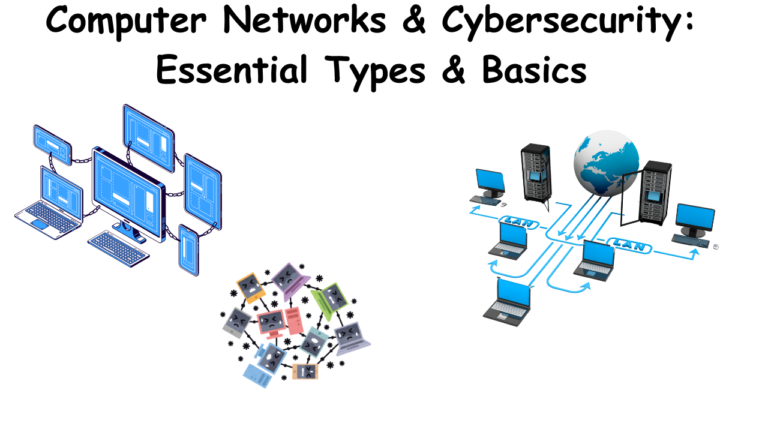Network Protocols and Port Numbers: A Comprehensive Overview
🌐 Network Essentials: Protocols & Port Numbers 🚪
In computer networking, “protocols” 📜 and “port numbers” 🚪 are essential concepts that work together to facilitate communication between devices. Here’s a breakdown:
📜 Protocols: The Language of Networks 🗣️
- Definition: 📝 A protocol is a set of rules that governs how data is transmitted over a network. It defines the format, order, and meaning of the messages exchanged between devices.
- Essentially, protocols are the “languages” 🗣️ that computers use to communicate with each other.
- Examples:
- TCP (Transmission Control Protocol): ✅ Reliable, ordered delivery of data. (Icon: 📦)
- UDP (User Datagram Protocol): ⚡ Faster, less reliable delivery of data. (Icon: 🚀)
- HTTP (Hypertext Transfer Protocol): 🌐 Transferring web pages. (Icon: 🌍)
- HTTPS (Hypertext Transfer Protocol Secure): 🔒 Secure version of HTTP. (Icon: 🔐)
- FTP (File Transfer Protocol): 📂 Transferring files. (Icon: 📁)
🚪 Port Numbers: The Doors to Applications 🚪
- Definition: 🔢 A 16-bit numerical identifier that allows multiple applications or services to run on the same computer and share a single network connection.
- Think of port numbers as “doors” 🚪 on a computer that allow specific applications to receive data.
- Function:
- When data arrives at a computer, the port number tells the operating system which application should receive it. (Icon: 🎯)
- They allow for multiplexing, meaning that many applications can use the same network connection at the same time. (Icon: 🔄)
- Ranges:
- Port numbers range from 0 to 65535. (Icon: 0️⃣-6️⃣5️⃣5️⃣3️⃣5️⃣)
- Well-known ports (0-1023): 🔑 Assigned to common services (e.g., HTTP on port 80, HTTPS on port 443). (Icon: 🔑)
- Registered ports (1024-49151): 📝 Can be assigned to specific applications. (Icon: 📝)
- Dynamic or private ports (49152-65535): ⏳ Typically used for temporary connections. (Icon: ⏳)
🤝 How They Work Together 🤝
- Protocols define the rules for communication, and port numbers specify which application should receive the data. (Icon: ⚙️)
- When a device sends data over a network, it includes both the destination IP address (identifying the computer) and the destination port number (identifying the application). (Icon: ➡️)
- The receiving computer uses the port number to direct the data to the correct application. (Icon: 📥)
📝 Summary 📝
In summary, protocols 📜 and port numbers 🚪 are fundamental to network communication. Protocols define the rules of communication, and port numbers allow for the simultaneous operation of multiple applications over a single network connection. (Icon: 🌐🤝🚪)

🚪 Common Port Numbers: A Quick Reference 🚪
It’s important to understand that there are a vast number of port numbers, but some are far more commonly used than others. Here’s a breakdown of some of the most significant ones, categorized for clarity:
🔑 Well-Known Ports (0-1023) 🔑
- 20, 21 – FTP (File Transfer Protocol): 📂
- 20: FTP data transfer. 📦
- 21: FTP control. ⚙️
- Used for transferring files between computers. 💻↔️💻
- 22 – SSH (Secure Shell): 🔐
- Used for secure remote access to computers. 🖥️➡️🔒
- 23 – Telnet: ⚠️
- Used for unencrypted remote access (less secure, so less common now). 🖥️➡️🔓
- 25 – SMTP (Simple Mail Transfer Protocol): 📧
- Used for sending email. 📤
- 53 – DNS (Domain Name System): 🌐➡️🔢
- Used for translating domain names (like “google.com”) into IP addresses.
- 80 – HTTP (Hypertext Transfer Protocol): 🌍
- Used for unencrypted web traffic. 🌐
- 110 – POP3 (Post Office Protocol version 3): 📥📧
- Used for retrieving email.
- 143 – IMAP (Internet Message Access Protocol): 📧🔄
- Used for managing email on a server.
- 443 – HTTPS (Hypertext Transfer Protocol Secure): 🔒🌐
- Used for encrypted web traffic. 🔐🌐
🛠️ Other Commonly Used Ports 🛠️
- 3389 – RDP (Remote Desktop Protocol): 🖥️➡️🖥️
- Used for remote access to Windows computers.
- 3306 – MySQL: 💾
- Used for MySQL database communications.
⚠️ Key Considerations ⚠️
- TCP vs. UDP: 📦⚡
- Many services can use either TCP (Transmission Control Protocol) or UDP (User Datagram Protocol). TCP provides reliable, ordered delivery, while UDP is faster but less reliable.
- IANA: 📜
- The Internet Assigned Numbers Authority (IANA) is responsible for maintaining the official list of port number assignments.
- Security: 🛡️
- It’s crucial to be aware of which ports are open on your network, as open ports can be potential security vulnerabilities. Firewalls are used to control network traffic and block unwanted access to ports. 🧱
🔒 Protocols & Ports: Your Cybersecurity Shield 🛡️
Here’s a detailed explanation of protocols 📜 and port numbers 🚪 and their significance in cybersecurity:
1. What is a Protocol? 📜
A protocol 📜 is a set of standardized rules that govern how devices communicate over a network. It defines:
- Data formats: 📦 How information is structured (e.g., headers, payloads).
- Transmission methods: ➡️ How data is sent and received (e.g., TCP vs. UDP).
- Error handling: 🛠️ How issues like lost packets are resolved.
Common Protocols in Cybersecurity 🌐
| Protocol | Layer (OSI) | Purpose | Security Relevance | Icon |
|---|---|---|---|---|
| HTTP | Application | Web browsing (unencrypted) | Vulnerable to eavesdropping, MITM attacks. | 🌍🔓 |
| HTTPS | Application | Secure web browsing (SSL/TLS) | Encrypts data to prevent interception. | 🔒🌐 |
| FTP | Application | File transfer (unencrypted) | Credentials sent in plaintext → Risk of theft. | 📂🔓 |
| SSH | Application | Secure remote access (encrypted) | Replaces insecure protocols like Telnet. | 🔐🖥️ |
| DNS | Application | Translates domain names to IPs | Vulnerable to spoofing (DNS poisoning). | 🌐➡️🔢 |
| TCP | Transport | Reliable, connection-oriented | Used for critical data (e.g., emails, banking). | 📦✅ |
| UDP | Transport | Fast, connectionless | Used for streaming, VoIP (vulnerable to DDoS). | ⚡🚀 |
| ICMP | Network | Network diagnostics (e.g., ping) | Exploited in ping floods (DDoS attacks). | 📡⚠️ |
Export to Sheets
2. What is a Port Number? 🚪
A port number 🔢 is a 16-bit identifier (0–65535) that directs network traffic to specific applications or services on a device. Think of it as an apartment number 🏠 in a building (IP address = building address).
Port Categories 🚪🔢
| Category | Range | Description | Examples (Port: Protocol) | Icon |
|---|---|---|---|---|
| Well-Known | 0–1023 | Reserved for common services | 80: HTTP, 443: HTTPS, 22: SSH, 53: DNS | 🔑 |
| Registered | 1024–49151 | Assigned to specific applications | 3306: MySQL, 3389: RDP | 📝 |
| Dynamic/Private | 49152–65535 | Temporary use by client applications | Used for P2P, gaming, etc. | ⏳ |
Export to Sheets
Why Protocols & Ports Matter in Cybersecurity 🛡️
- Attack Surface Identification: 🎯
- Open ports = potential entry points for attackers.
- Example: An open Port 22 (SSH) 🖥️➡️🔐 can be brute-forced.
- Example: Port 445 (SMB) 📂 is exploited in EternalBlue attacks.
- Firewall & Network Security: 🧱
- Firewalls block/allow traffic based on port numbers 🚪 and protocols 📜.
- Example: Blocking Port 23 (Telnet) ⚠️ to prevent unencrypted logins.
- Intrusion Detection: 🚨
- Unusual port activity = red flag (e.g., Port 6667 👾 for IRC malware communication).
- Exploit Delivery: 📦➡️💣
- Malware often uses specific protocols/ports:
- HTTP/HTTPS (Port 80/443): Bypass firewalls (common in phishing). 🎣
- DNS (Port 53): Data exfiltration via DNS tunneling. 🌐➡️🤫
- Malware often uses specific protocols/ports:
- Secure Configuration: ⚙️🔒
- Disabling unused protocols/ports reduces attack surface.
- Example: Disable FTP (Port 21) 📂 and use SFTP (Port 22) 🔐📂 instead.
Common Attacks Targeting Protocols & Ports 💥
- Port Scanning: 🔍🚪 (Nmap)
- DDoS Attacks: 💥📡 (UDP/ICMP floods)
- Man-in-the-Middle (MitM): 👤➡️🌐 (HTTP, FTP)
- Credential Theft: 🔑盗窃 (FTP, Telnet)
- Ransomware Propagation: 🔐🦠 (SMB Port 445)
Security Best Practices ✅
- Close Unused Ports: 🚪🧱
- Encrypt Traffic: 🔒➡️🌐 (HTTPS, SSH, SFTP)
- Monitor Port Activity: 👁️🗨️📊 (SIEM tools)
- Patch Services: 🛠️🛡️ (SMB, RDP)
- Port Hiding: 🚪➡️🤫 (non-default ports)
Example: Securing a Web Server 🌐🛡️
- Open: Port 80 (HTTP), Port 443 (HTTPS).
- Close: Port 22 (SSH) if unused, or restrict access via IP whitelisting.
- Monitor: Traffic on Port 443 for SQL injection or XSS attacks.
Tools for Analyzing Protocols & Ports 🛠️🔍
- Nmap: Port scanning and service detection. 🔍🚪
- Wireshark: Protocol-level traffic analysis. 📡🔬
- Netstat: List open ports on a local machine. 🖥️🚪
- Nessus: Vulnerability scanning based on open ports. 🛡️🔍
Key Takeaway for Cybersecurity 🔑🔒
Understanding protocols and ports is foundational for:
- Securing networks 🧱🛡️ (firewalls, IDS/IPS).
- Investigating breaches 🕵️♂️🔍 (log analysis).
- Ethical hacking 💻🔒 (penetration testing).




